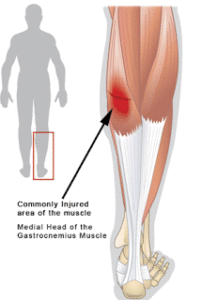 Tennis leg is a general term used to describe pain in the leg typically caused by a tear of the medial gastrocnemius muscle (inner head of the big calf muscle). It is a somewhat common injury in middle-aged athletes that we at BTF would categorize as “weekend-warriors”. This athlete usually has a somewhat sedentary occupation, but when the weekend rolls around, they play hard! Sometimes they don’t have an adequate or even any warm-up strategy prior to their games. It is thought that because tennis is a game that involves quick accelerations, jumping and changes of direction, the calf muscles are under a high amount of stress and become prone to injury, especially in a weekend warrior that has less than adequate fitness. Of course this injury could happen to any athlete in any sport or activity.
Tennis leg is a general term used to describe pain in the leg typically caused by a tear of the medial gastrocnemius muscle (inner head of the big calf muscle). It is a somewhat common injury in middle-aged athletes that we at BTF would categorize as “weekend-warriors”. This athlete usually has a somewhat sedentary occupation, but when the weekend rolls around, they play hard! Sometimes they don’t have an adequate or even any warm-up strategy prior to their games. It is thought that because tennis is a game that involves quick accelerations, jumping and changes of direction, the calf muscles are under a high amount of stress and become prone to injury, especially in a weekend warrior that has less than adequate fitness. Of course this injury could happen to any athlete in any sport or activity.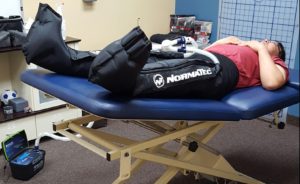
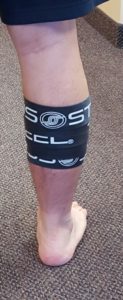
Compression – Use compression of the injured area in the form of bands, sleeves, compression clothing etc.. At BTF, we like to use the NormaTec as a passive form of compression that helps with lymphatic drainage. We also use compression bands (also called Voodoo bands because of their “magic” healing properties).
Elevation – This is a helpful way to assist with lymphatic drainage. Try to get the injured calf elevated as many times per day as possible with the addition of compression to speed your recovery.
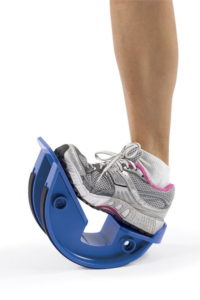
Movement – If it is too painful to walk then crutches may be beneficial as partial weight bearing is recommended. Full weight bearing and walking normally should be done as soon as pain allows. Mobility exercises and gentle calf stretching should be started as soon as possible. As soon as normal walking is pain free then strengthening exercises should begin.
Heel Stair Descents
Biomechanical treatment strategy (for healthcare geeks only!)
To diminish strain on the medial gastrocnemius, the calcaneus needs to be centered at heel strike. This means calcaneal eversion exercises, especially on the right side. If exercises do not sufficiently fix the calcaneal eversion limitation, changing shoes and/or custom orthotics can be helpful.
If you have an injury, please contact us at info@backtofunction.com or call 310-534-1900. Feel better and perform better today!
References
http://www.sportsinjuryclinic.net/sport-injuries/ankle-achilles-shin-pain/tennis-leg
Postural Restoration Institute, Impingement & Instability Course Manual, May 14-15, 2016.


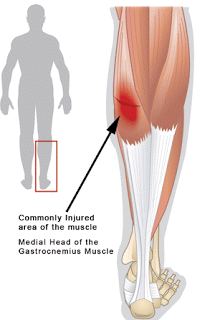

Thank you for providing this information. I believe this nails the problem precisely on the head, and provides some useful advice for the recovery process.
Thanks for the feedback David!